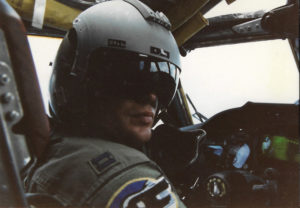Professor Steve Call, Ph.D., Lt. Col. USAF (Ret.)

It helps to know a little something about your professor; not only for the “human dimension,” but also so that you feel confident that what you are learning comes from someone who knows something worth knowing, at least as far as this particular subject is concerned.
In this case, this course is central to preparing you for your career as a military professional, so let me say a little about why you, as an aspiring military professional, want to take this course, and why you want to take what I have to say seriously.
It all boils down to two reasons: 1), my record as a professional military officer, and 2), my record as a professional military historian.

My Air Force Officer Career
I got my commission from the Air Force Officer Training School back when it was located at Medina Annex, part of Lackland Air Force Base, back in 1982. I then went to Laughlin Air Force Base in Del Rio, Texas, for Pilot Training. I graduated in April 1983 with an assignment as a B-52 pilot; following B-52 training, I was stationed first at Ellsworth Air Force Base near Rapid City, South Dakota, and then later at Loring Air Force Base, near Caribou, Maine. Throughout those years I was a frontline combat pilot of the Cold War. As such, I was part of America’s defense against a full-scale nuclear war with the Soviets. I spent that entire period training for nuclear war and “sitting alert” as part of America’s first response to nuclear attack. After roughly two years as a co-pilot, I upgraded to aircraft commander; I also served a tour as a command post controller coordinating the base’s day-to-day operations. In 1986 I began what was intended to be a career-broadening staff assignment as a history professor at the Air Force Academy. This entailed getting my masters degree in military history at the University of Nebraska-Lincoln under Professor Pete Maslowski. In the midst of that assignment the Soviet Union collapsed, the Cold War ended, and the Air Force reduced its B-52 fleet by over two-thirds. In the midst of this dramatic military realignment I won a prestigious scholarship under the sponsorship of an Air Force think tank to obtain my Ph.D. in military history at Ohio State under Professor Allan Millett. After obtaining my degree, I went to work at the Pentagon on the Air Staff and put my professional and academic experience to use dealing primarily with Joint air-to-ground issues. Following my Pentagon tour I served as a liaison officer with the Army attached to the 10th Mountain Division at Fort Drum, near Watertown, New York. In many ways, this assignment was the culmination of my entire career as I was responsible for helping the division integrate air power into the ground war at the division level, thus wrestling with many of the foremost issues confronting America’s air-ground combat teams on the eve of 9/11.
My Academic Career
Shortly before 9/11 I retired from the Air Force and resumed my career as a history professor by taking a position at SUNY Broome. While hired as a European historian, I found several opportunities to teach military history. In fact, the genesis for this course was a forward-thinking department head who, a year after 9/11, asked me to develop and teach a course that reflected the West’s long history with warfare. I took the basic one-semester “Introduction to Military History” course I had taught at the Air Force Academy and folded in themes emphasized in a standard Western Civilization course to illustrate how the two areas of historical development influenced each other. Since then I have taught courses in American history, the U.S. Civil War, World War II, and the Vietnam War, all the while still remaining grounded in European history and Western Civilization. This course has benefitted from that wide-ranging experience as I have sought to answer questions related to both the civilian and the military perspectives of all the courses I have taught, making my insights on the interactions of civilian and military events, institutions, and perspectives all the richer in the process.
I have also pursued an active career of research and publication. In 2006 Texas A&M University Press published Danger Close: Tactical Air Controllers in Afghanistan and Iraq, my analysis of how tactical air controllers contributed to the overthrow of both the Taliban regime in Afghanistan and Saddam Hussein’s rule over Iraq. In 2009 Selling Air Power: Military Aviation and American Popular Culture after World War II came out, also published by Texas A&M. In this book I examine how air power advocates sought to shape American public perceptions of air power in their effort to entrench their theories of air power doctrine. Additionally I have published a number of articles and presented a number of papers at history conferences across the country. The textbook for this course represents my third major publication.
Contact Me
Location: TH-109C
Phone: (607) 778-5097
Email: callsc@sunybroome.edu